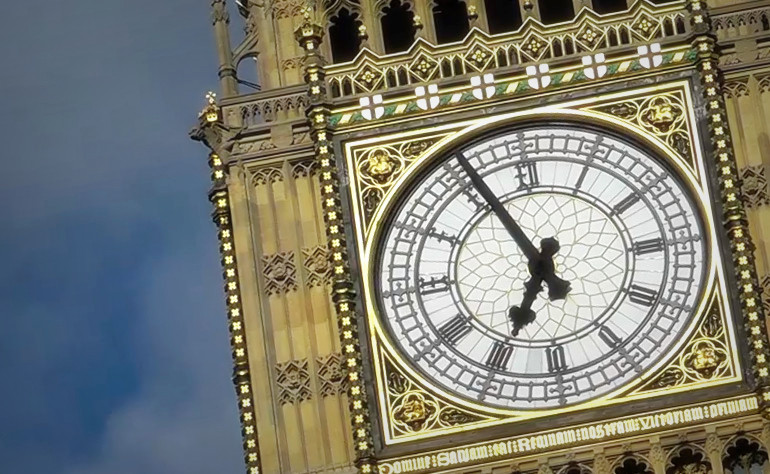
We are presently in the midst of the month of Tishray, the seventh month. We find that six mundane units are followed by a holy seventh. The six days of the week are followed by Shabbos. Each six-year cycle is followed by the Shmittah year (no work is performed on the fields). And the first six months are followed by Tishray, the month that is illuminated by so many holidays.
In order to understand the connection and transition from Yom Kippur, the Day of Atonement, to Succos, the holiday of the Clouds of Glory, we must have an historical perspective.
On the fifteenth day of Nissan, Bnei Yisroel {the Children of Israel} had their exodus from the oppressive slavery of Mitzrayim {Egypt}. The travel through the wilderness was accompanied by the ‘Annanei Hakavodthe Clouds of Glory’ that led the way while also casting their protective shield over the nation.
Forty-nine days later, on the sixth day of Sivan, Bnei Yisroel stood by the foot of Har {Mount} Sinai as the heavens opened up and all heard the word of Hashem. Moshe then ascended the mountain to remain there for forty days in order to be taught the entire Torah and to then bring down the Luchos {Tablets upon which the Ten Commandments were written}.
Bnei Yisroel miscalculated, thought that Moshe was dead, and sinned by making the Golden Calf. Moshe descended on the seventeenth day of Tammuz, saw the Golden Calf, and broke the Luchos. As a result of that, the ‘Annanei Hakavod’ were withdrawn.
Moshe ascended the mountain again to plead forgiveness on behalf of Bnei Yisroel. On Yom Kippur, the tenth of Tishray, Moshe descended carrying Hashem’s message of “Salachti–I have forgiven.” On the next day Moshe gathered Bnei Yisroel to command them to bring sacrifices, which were then brought on the twelfth and thirteenth of Tishray. On the fourteenth, the materials that Moshe had collected were brought to the artisans who would be constructing the Mishkan {Tabernacle} and on the fifteenth the actual construction began.
On that day, the Annanei Hakavod returned and served as a Succah–the loving protection that Hashem gave to His children. We reenact that display of love and intimacy by moving out of our houses into the Succah each year on the fifteenth day of Tishray.
Closeness, distance and then an even greater closeness. We don’t commemorate those first Annanei Hakavod–they didn’t last. It is the Annanei Hakavod that followed the repentance that are commemorated yearly. Closeness, distance and then an even greater closeness. This is a pattern that is repeated not only on a national level but also on an individual one.
One of the most moving stories I’ve ever heard is told in Hasidic Tales of the Holocaust about a young girl named Ida. In 1944, she, her family and the rest of her Czechoslovakian town were sent to Auschwitz. The arrival platform was the last time she saw her family as only she and a sister passed the selection. She was given the job of sorting the clothes of the gassed according to size and quality to ready them for usage by German civilians.
One night, a strange noise was heard under the three-tiered bunk bed where Ida slept along with thirty-five other girls. The other eleven had to turn in order to enable Ida to get out and see what was causing this noise. Under the bed, curled up into a frightened ball, she found a little girl who had escaped the children’s Aktion by hiding in the latrine and had later hid herself in the barracks.
The girl’s name was Estherke and she had big blue frightened eyes and beautiful blond curls. Ida immediately fell in love with Estherke as her life took on renewed purpose and meaning–saving the life of Estherke. Her meager bread rations were split in half and somehow managed to sustain them both.
When her camp was going to be evacuated Ida knew that Estherke would never pass the selection. She worked out a plan where Estherke, bundled in a blanket, was thrown over the electrified fence into the waiting arms of a male inmate in the adjacent men’s camp. Later that afternoon the package was sent again into the awaiting arms of Ida now in her new camp.
In January 1945, when the camp was again evacuated, Ida had Estherke on her back in a knapsack as she began the infamous death march. Through winds and snow Ida marched on with her precious cargo until they arrived in Bergen Belsen.
After months of horror, in April 1945, Ida, her sister, Estherke and the rest of those who had somehow managed to survive were liberated by the British. All wanted to return to their hometowns to see who might still be alive. For the first time since that fateful night in Auschwitz, Ida had to part from Estherke. They agreed to meet back in Prague in two weeks time no matter what the outcome of their searches would be and each went their way.
The two weeks passed, Ida returned to Prague but Estherke failed to return. Months of intensive search yielded nothing. Estherke seemed to have vanished.
Ida met and married a survivor and moved to America. Her sister outmaneuvered the British blockade and made her life in Israel.
In the early 1950’s, Ida went to Israel to visit her sister. On a very hot day she fainted in the street and was brought to a hospital by two young soldiers. A friendship developed and they visited her each day.
As Ida was being discharged, she asked them how she could repay their kindness. One of them told her that he was getting married the next day and he’d want her to be at the wedding.
And so, with a gentle breeze blowing off the mountains of Jerusalem, Ida found herself among other guests trying to find a familiar face. “The bride is coming,” someone near her said. Ida moved forward to get a glimpse of the girl that had been described so lovingly. The door opened and she watched in amazement as her beloved Estherke walked in. And so, under the bright stars shining over the Holy City, Ida stepped forward and escorted her Estherke to the chupah {bridal canopy}. Closeness, distance and then an even greater closeness. The odyssey of Ida and Estherke. The odyssey of the Annanei Hakavod returning after the forgiveness of Yom Kippur. The odyssey that every soul takes as it departs from the heavenly sphere to enter the earthly realm, only to later return bearing the fruits of its earthly journey.
There is another group of ordinary six that is followed by a holy seventh. The world will exist for six thousand years and then, after the transformation that the Moshiach will have brought toward the end of those six thousand, it will be rebuilt for the holy seventh.
May this be a year of blessing and redemption, where the world will leave its present state of distance and confusion to begin the era of ultimate closeness.
Wishing you all a g’mar chasima tova, a meaningful Yom Kippur and a joyous Succos,
Yisroel Ciner
Copyright © 2001 by Rabbi Yisroel Ciner and Project Genesis, Inc.
The author teaches at Neveh Tzion in Telzstone (near Yerushalayim).


